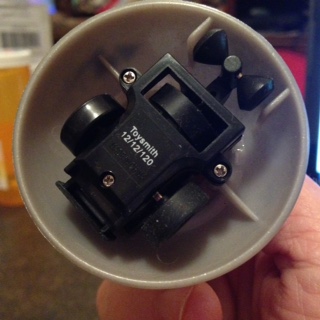Simple Mechanical Device for Edge Sensing - erco?
Have seen simple toys like this that "sense" the table edge and turn before falling. I love solutions like this that are more a mechanical trick rather than a sensor and program. The idea is something that handles this function and does not use any processing time or power...
See here - https://www.youtube.com/watch?v=NaedPL-0zgU
I think it has a set of free spinning wheels (just rollers) that hold a constantly turning wheel that is at a right angle to the drive wheels just above the table surface. When the rollers drop of the table edge, the spinning wheel drops to the table surface and it turns the device away from the edge. As it does, the rollers come back up on the table and lift the "turning" wheel of the surface - disengaging it. Hard to describe, but ingenious and works well.
Has anyone seen this on something more that just a toy - a more sophisticated robot for instance?...erco? - I know you know this one!
Here is a photo of the bottom of such a toy...
See here - https://www.youtube.com/watch?v=NaedPL-0zgU
I think it has a set of free spinning wheels (just rollers) that hold a constantly turning wheel that is at a right angle to the drive wheels just above the table surface. When the rollers drop of the table edge, the spinning wheel drops to the table surface and it turns the device away from the edge. As it does, the rollers come back up on the table and lift the "turning" wheel of the surface - disengaging it. Hard to describe, but ingenious and works well.
Has anyone seen this on something more that just a toy - a more sophisticated robot for instance?...erco? - I know you know this one!
Here is a photo of the bottom of such a toy...




Comments
Yes, that is quite ingenious.
From the link and photo that you provided, I tried to find more information. I would imagine that the concept could possibly have a patent involved. As far as I can tell from the photo that you provided, there is one distinct set of numbers and letters, and I believe there is another set of numbers, but I am really not certain.
And I agree, all-mechanical solutions are often better than electronic. The useless box I made is all mechanical (ok, one diode) but I have seen some made using an Arduino. Drastic overkill IMO.
"t has two back wheels that power the robot, two front sensor wheels and one middle perpendicular wheel. As soon as the front wheels start to go off the edge of the table, the robot lowers a bit which then causes the middle perpendicular wheel to hit the table and turns the car back onto the table driving surface."
My reading of this would be that only the two back wheels, powered by a single motor, move the robot. The others are just free-wheeling, with the middle wheel set a little shallow so it doesn't otherwise touch the surface unless the front wheels dip.
For obvious reasons, it works only on absolutely flat surfaces.
-Phil
@idbruce - thanks for noticing the numbers - I had not paid attention to that. The toys are so cheap - they have either stolen the idea or any royalties for using the idea must be pennies!
@erco - I knew you'd be familiar with this idea. It is neat and simple.
@Gordon - perfect description - that is exactly right.
@Phil - correct Sir. It may be delicate, but it works really reliably and is so simple.
Other notes...
The two front roller wheels are cone shaped with the points of the cone connecting to the axle - so the roll on the edge of the cone (where the ice cream goes!). The axel is loose fitting and when one wheel drops off the edge of the table, the remaining wheel tilts up - dropping the sideways drive wheel (the one at right angle to the real drive wheels) to the table surface. This then steers the toy/bot from the edge of the table.The cone shaped rollers slide back on to the table and raise the sideways drive wheel at the same time, ending the turn.
In the toy - the sideways drive wheel only turns in one direction and runs constantly - like the main drive wheels - which also only move in a forward direction - that is toward the cone shaped roller wheels. So the toy always moves forward and always turns right when it hits a table edge.
I think I would like my version to be a bit more complex. See the two modified photos. Depending on which roller wheel drops of the edge first, the bot would turn the opposite direction. This could be done with simple switches like whisker turning.
-Phil
You are correct, sir. They largely run in a circular pattern which sets them up for proper function, but you can definitely aim these guys so they can't recover and take the plunge.
As we know the perpendicular wheel is right in the center, so the robot turns within its own circle. As long as the center wheel is going (much) faster than the drive wheels in the back, it shouldn't run off the edge in most cases. In the video the robot that falls gets pushed off by the one behind it.
In rechecking the video just now to remind myself how the falling robot erred, the mystery can be solved by carefully freeze-framing the clip right at the moment of impact. The guts aren't quite the same as Whit's photo. In the video, the front "wheels" appear to be really just plastic skids at about the 11 and 1 o'clock position; the center wheel is clearly shown, and is pretty big, and the drive wheels are well spaced apart in the back.